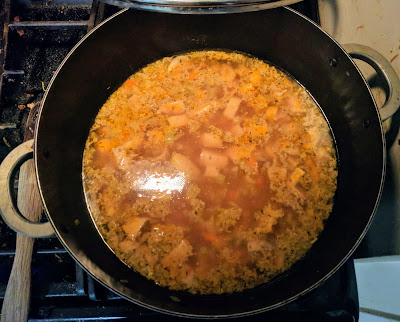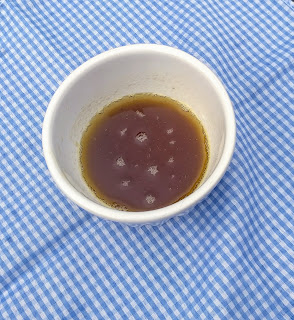Red Meat Stock
I'll be perfectly honest: I normally like to add a few more vegetables and seasonings to my stock. However, in the interest of authenticity I have followed the traditional recipe from its origins in the Shiverpeaks. Even with the reduced ingredient list, it still makes a wonderfully rich stock. And it can be a great way to use up kitchen scraps too!
Dolyak tends to be the red meat of choice up in the Shiverpeaks, and this stock is no exception. The large marrow bones are roasted for flavour and tossed into huge pots where they simmer over the fire for a day or more. Once it's had sufficient time to cook, the collagen-rich, meaty broth is strained off and used in a variety of soups and stews.
Further south, venison is the preferred protein. Deer tend to be quite a bit leaner than dolyak, so the broth isn't quite so rich and unctuous. It still makes a lovely backdrop for a soup though.
Obviously dolyak are not on the menu here. There are however a number of other possible candidates: yak, bison, muskox, beef, venison, elk, mutton, or goat would all make reasonable choices. Perhaps even a combination! A medley of beef, bison, and goat bones would probably get you pretty close to the classic dolyak flavour. I've chosen to use plain beef in this adaptation due to its easy availability.
1 Use only 2L of water if simmering in a slow-cooker/multi-cooker. Start with 2.5L of water if simmering on the stove. Check periodically during cooking to see if more water needs to be added. Back
2 Carrot peels, garlic and/or onion skins, pepper seeds, bean ends, herb stems, leek tops, etc. I collect mine in the freezer until I've filled a bag. They can be added to meat stocks like this or used on their own to make vegetable broth. Although, if you are planning to make vegetable broth, adding a few spices and a bit of fat will make it even better. Back
Dolyak tends to be the red meat of choice up in the Shiverpeaks, and this stock is no exception. The large marrow bones are roasted for flavour and tossed into huge pots where they simmer over the fire for a day or more. Once it's had sufficient time to cook, the collagen-rich, meaty broth is strained off and used in a variety of soups and stews.
Further south, venison is the preferred protein. Deer tend to be quite a bit leaner than dolyak, so the broth isn't quite so rich and unctuous. It still makes a lovely backdrop for a soup though.
Obviously dolyak are not on the menu here. There are however a number of other possible candidates: yak, bison, muskox, beef, venison, elk, mutton, or goat would all make reasonable choices. Perhaps even a combination! A medley of beef, bison, and goat bones would probably get you pretty close to the classic dolyak flavour. I've chosen to use plain beef in this adaptation due to its easy availability.
 |
| Once cooled, the stock should congeal into a solid, meaty jelly. |
Beef Stock
Ingredients
- 1.6-1.8kg beef bones
- 2 onions, quartered (no need to peel)
- 2 large carrots, cut into 5cm (2") lengths (no need to peel)
- 2-3L water1
- 2 Tbsp. black peppercorns
- 1 tsp. coarse sea salt
- vegetable scraps2
Directions
- Combine bones, onions, and carrots and roast for 45 minutes at 230°C (450°F).
- Transfer bones and vegetables to pot.
- Pour water into roasting pan and stir and scrape up any bits stuck to the bottom.
- Add water to pot along with peppercorns, salt, and any vegetable scraps on hand.
- Bring to a boil.
- Reduce heat and simmer for 8-24 hours.
- Strain.
- Discard the vegetables.
- Pick any meat from the bones and add it to the strained broth. Discard the bones.
1 Use only 2L of water if simmering in a slow-cooker/multi-cooker. Start with 2.5L of water if simmering on the stove. Check periodically during cooking to see if more water needs to be added. Back
2 Carrot peels, garlic and/or onion skins, pepper seeds, bean ends, herb stems, leek tops, etc. I collect mine in the freezer until I've filled a bag. They can be added to meat stocks like this or used on their own to make vegetable broth. Although, if you are planning to make vegetable broth, adding a few spices and a bit of fat will make it even better. Back



Comments
Post a Comment